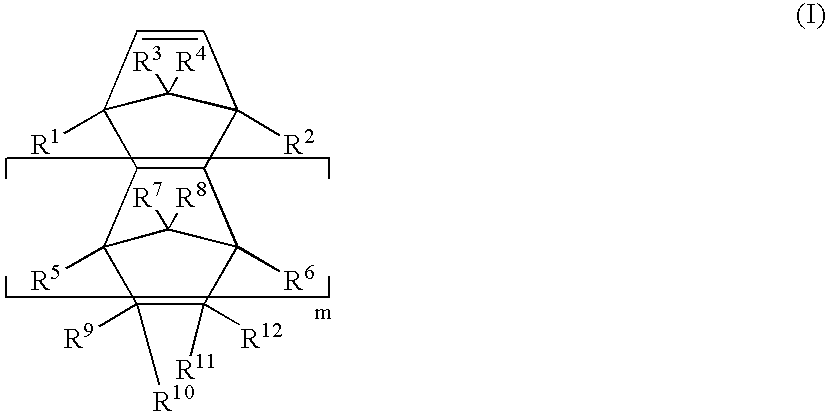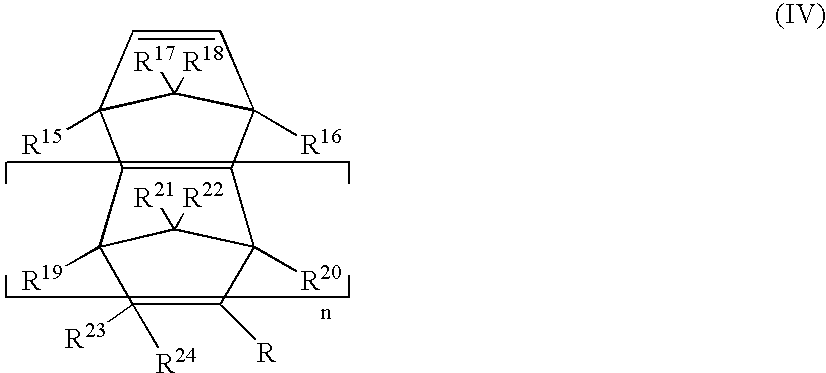Polyolefin resin composition
a polyolefin-based resin and composition technology, applied in the field of polyolefin-based resin composition and molded articles produced there, can solve the problems of inability to achieve the high-quality improvement of properties or various excellent properties, composite materials that fail to exhibit excellent combined properties of respective polyolefin-based resins, and failure to produce polymers with isotactic or syndiotactic structures capable of showing a more excellent heat resistan
- Summary
- Abstract
- Description
- Claims
- Application Information
AI Technical Summary
Benefits of technology
Problems solved by technology
Method used
Image
Examples
case 1
[0121]In the case of using as a comparative specimen, a polyolefin which is produced under the same conditions as those of the graft copolymer except for using no polyene, and has a molecular weight distribution [weight-average molecular weight (Mw) / number-average molecular weight (Mn)] of 0.8 to 1.8 times that of the graft copolymer:
[0122]When the following formula (a) wherein N1 represents the value of ω2 / 10ω1 of the graft copolymer and N0 represents the value of ω02 / 10ω1 of the comparative specimen is satisfied, it is determined that the polyene unit is present in the graft copolymer.
case 2
[0123]In the case where the comparative specimen is made of a polyolefin apparently containing no branched structure and having the same kind and content of constituting monomer units as those of the graft copolymer, the polyene unit content in the graft copolymer is determined by the following method.
[0124]Here, the “same content of constituting monomer units” means that the comparative specimen is made of either one of the following materials:
[0125](1) Polyolefin having the same sequences as those of the graft copolymer except for sequences derived from the polyene unit; and a polymeric structure other than a grafting structure whose monomer composition is substantially the same as that of the graft copolymer; and
[0126](2) Polyolefin mixture containing the polyolefin having the same sequences as those of the graft copolymer except for sequences derived from the polyene unit, and the other polyolefin having a polymeric structure other than a grafting structure, whose monomer compos...
production example 1
Production of HDPE-g-ENB
(1) Preparation of Aluminum Oxy Compound
[0193]One thousand milliliters of a toluene solution of methyl aluminoxane (1.47 mol / liter; available from Albemarle Corporation; containing 14.5% by weight of trimethyl aluminum) was distilled at 60° C. under reduced pressure (2,660 Pa) to remove the solvent therefrom, and allowed to stand under this condition for 4 hours. The resultant product was cooled to room temperature to obtain a dried-up methyl aluminoxane.
[0194]Then, dehydrated toluene was added to the dried-up methyl aluminoxane to dissolve the latter again and obtain a toluene solution thereof having the same volume as that before the distillation. As a result of 1H-NMR of the resultant solution, it was confirmed that the amount of trimethyl aluminum contained in the methyl aluminoxane was 3.6% by weight. Also, as a result of the measurement by fluorescent X-ray (ICP) method, it was confirmed that the total amount of aluminum contained in the methyl aluminox...
PUM
| Property | Measurement | Unit |
|---|---|---|
| Temperature | aaaaa | aaaaa |
| Temperature | aaaaa | aaaaa |
| Percent by mass | aaaaa | aaaaa |
Abstract
Description
Claims
Application Information
 Login to View More
Login to View More - R&D
- Intellectual Property
- Life Sciences
- Materials
- Tech Scout
- Unparalleled Data Quality
- Higher Quality Content
- 60% Fewer Hallucinations
Browse by: Latest US Patents, China's latest patents, Technical Efficacy Thesaurus, Application Domain, Technology Topic, Popular Technical Reports.
© 2025 PatSnap. All rights reserved.Legal|Privacy policy|Modern Slavery Act Transparency Statement|Sitemap|About US| Contact US: help@patsnap.com



